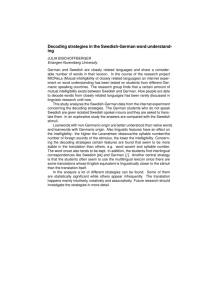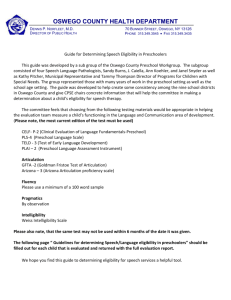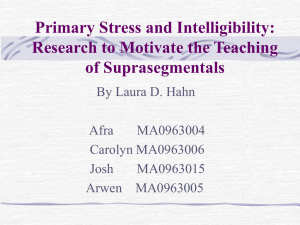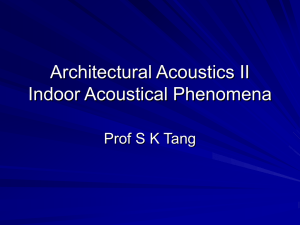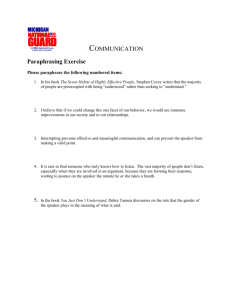IPW1-Flipsen(2000)
advertisement
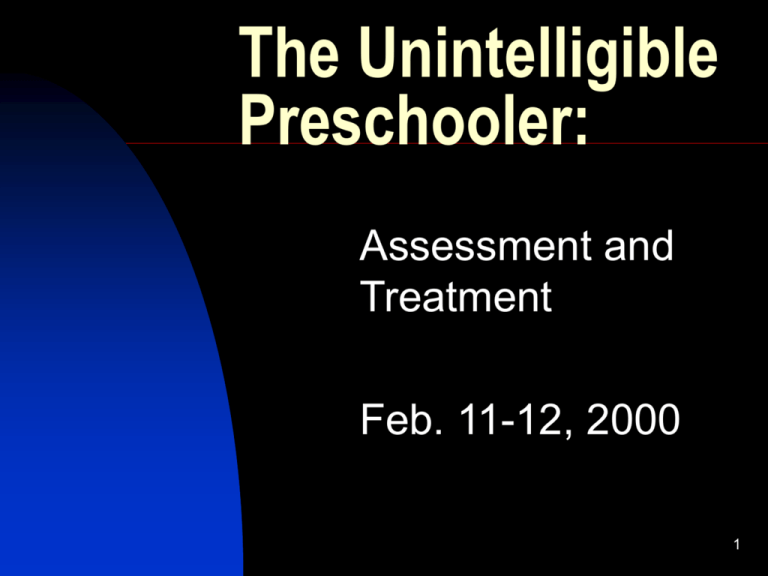
The Unintelligible Preschooler: Assessment and Treatment Feb. 11-12, 2000 1 Peter Flipsen Jr., Ph.D. Assistant Professor of Communication Disorders Minnesota State University, Mankato ASHA Certified (CCC-SLP) Minnesota Title Registered (SLP) Canadian Certified (S-LP(C)) 2 Course Objectives: Identify factors that contribute to the intelligibility of speech Select appropriate test materials for unintelligible preschoolers Identify the nature of intelligibility deficits in unintelligible preschoolers Select appropriate treatment strategies Incorporate parents into treatment programs 3 Overview Part 1 - Assessment Review intelligibility as a concept Review factors contributing to intelligibility Review assessment of intelligibility Discuss possible factors contributing to intelligibility deficits Review procedures for evaluating each of the factors 4 Overview Part 2 – Intervention Dealing with short-term issues Dealing with structural problems Dealing with motor problems Dealing with resonance problems Dealing with linguistic problems Incorporating parents 5 Pretest 6 Who Are We Talking About? Preschool children who are otherwise typically-developing but who present with speech that is unusually difficult to understand One or both parents may be good “translators” but most unfamiliar listeners have difficulty communicating with these children. 7 Some examples: Faustin – age 6;0 Dylan – age 5;1 Aaron – age 4;1 8 Who these children are not. Not hearing impaired No obvious structural problems No frank neurological impairments No major cognitive deficits No problems with receptive language 9 Consequences of Being Unintelligible Communication is not effective May reduce attempts to speak Limits practice time for learning language Increasing frustration May lead to behavior problems Reduced message complexity Shorter utterances more easily understood 10 Consequences of Being Unintelligible Limited practice time may account for why many of these children also have expressive language delays (Miller & Leddy, 1998) Some emerging evidence that significant delays in speech acquisition lead to later problems with reading acquisition 11 Historical Pattern Up until the early 70s these children were seen as having “functional articulation disorders” Implied that it was a problem learning how to say the sounds 1970s -sudden shift to saying they had “phonological impairments” Implied that it was a problem knowing where to use the sounds 12 The Clinical Puzzle Difficult to define the specific nature of the problem these children are having Also difficult to know what the best treatment approach might be 13 The Clinical Solution? Both of the historical labels assumed that this was a single group No single approach to treatment seems to work for all of them Very likely the problems are based in a variety of causes Need to identify the likely cause for each child if possible 14 Part I - Assessment 15 The Concept of Intelligibility Understandability How effectively a person can get their message across The goal of every communication event “… the functional common denominator of verbal behavior.” - Kent et al. (1994) 16 Factors Affecting Intelligibility The listener The listening environment The speaking context (pragmatic and linguistic) The speaker 17 Listener Factors Hearing acuity For most clinical purposes, we select listeners with normal hearing Receptive language skills For most clinical purposes, we select listeners with normal skills 18 Listener Factors Familiarity with speaker personally Parents (and anyone who spends much time with these children) quickly become “biased” listeners Learn to ‘translate’ the abnormal patterns 19 Flipsen (1995) Study of parents as “familiar” listeners Four children tested longitudinally while in therapy Made recordings of children speaking single words (Y-B test) Mothers, fathers and unfamiliar listeners tried to identify words 20 Flipsen (1995) Mothers understood significantly more of the words than any of the other listeners Fathers were not significantly better than the unfamiliar listeners Appeared that mothers were spending much more time with the children (not formally measured) 21 Listener Factors Familiarity with the material being produced If you’ve heard the “Rainbow passage” 50 times you come to know what to expect If you chose the sentences to be read you know what to expect 22 Listener Factors Familiarity with the speaker’s population Particular disorder groups do tend to have similar overall speech patterns The more time you’ve spent with those groups the more easily you are able to understand them 23 Listener Factors Familiarity with disordered speech in general Experienced SLPs better at understanding disordered speech than non-SLPs 24 Environmental Factors Affect both speaker and listener Noise levels Presence / absence of visual distractions Comfort level THESE CAN USUALLY BE CONTROLLED FOR MOST CLINICAL PURPOSES 25 Contextual Factors Speaking Task Conversation Monologue Reading Material being produced Connected Text Sentences Single words 26 Contextual Factors Usually see an interaction between level of intelligibility and the type of material being produced Speakers with milder intelligibility deficits tend to do better with connected contexts Speakers with more severe intelligibility deficits tend to do better with single-word context 27 Fig. 1 28 Fig. 1a 29 Speaker Factors Cognitive skills Usually doesn’t impact intelligibility except at very low levels Poor presuppositional skills – may not provide all the necessary info May also see speech motor skills deficits in those with more severe cognitive deficits 30 Speaker Factors Expressive language skills Vague vocabulary may be a problem Missing morphological markers may also interfere Force the listener to have to work harder to process the information 31 Speaker Factors Phonological skills Includes knowledge of: phonemes allophones morpheme structure rules and sequential constraints morphophonemic rules 32 Speaker Factors Speech Motor Skills Ability to formulate and transmit the neuromotor instructions Frank dysarthria and dyspraxia readily reduce intelligibility Affect both accuracy and timing of segment production 33 Speaker Factors Hearing Acuity Clearly if you can’t hear what you’re producing, you will have difficulty producing it accurately Not a factor in the group we’re discussing 34 Speaker Factors Auditory Perceptual Skills Not a major issue for all these children Some may have problems with perceiving the difference between sounds they have difficulty producing and what substitute 35 Speaker Factors Status of the physical mechanism Most minor structural problems are not a problem by themselves It is possible however for several of these to combine with each other to make the task of producing speech more difficult 36 Speaker Factors Voice Quality Harsh or hoarse voice adds noise to the signal making it harder to understand Higher pitched voices in children are by definition ‘thinner’ (fewer harmonics) making them more susceptible to effects of other factors 37 Speaker Factors Resonance Status Hyponasal (denasal) speech can be harder to understand because of the loss of oral-nasal contrasts Nasal consonants account for about 10% of all speech sounds Rarely a major factor however 38 Speaker Factors Hypernasal speech has a more serious impact on intelligibility Nasal cavity resonances are low intensity (hard to hear) Nasal cavity has anti-resonances that cancel out some acoustic energy making the output even harder to hear 39 Speaker Factors Articulation Skills The ability to produce the individual speech sounds Speakers with few errors may still be unintelligible Speakers with many errors may be quite intelligible 40 Fig. 2 41 Fig 2a 42 Fig 2b 43 Speaker Factors Speech sound production skill only accounts for 20-50% of the variance in intelligibility 44 Speaker Factors Prosodic Skills Excessively fast or slow rate may reduce intelligibility Clutterers use extreme rate – hard to process what they are saying Classic strategy in adult dysarthria is to have them slow down If speech is too slow, listener may lose track of the whole message 45 Speaker Factors Atypical stress patterns may also reduce intelligibility e.g., stress on wrong word in sentence or on the wrong syllable in a word or too little stress Listeners rely on stress to assist with sorting out the words e.g., many N-V pairs differ only on stress 46 Speaker Factors Motivation and effort We all know people who appear to “mumble” at times but can make themselves understood if they choose to And when we ask some speakers to repeat, they may change what they do and the result is an improved signal 47 Speaker Factors Nonverbal communication skills (i.e., gestures) may play a role Recent study by Garcia & Cobb (1998) showed that gestures also contribute to message understanding in adult dysarthria (only 2 speakers studied however) 48 Intelligibility and Severity NOT the same thing though often highly correlated. A child producing many speech sound distortions may be quite intelligible but may be rated as moderately impaired. A child with a harsh voice may be quite intelligible but listeners have to work harder to understand him. 49 Intelligibility Clearly a very complex phenomenon It is not surprising that it is not well understood by clinicians 50 Intelligibility Probably not meaningful to speak of a single value. Each individual probably has a range of “intelligibility potentials” (Kent et al., 1994). 51 Reporting Intelligibility To be meaningful, the following need to be reported: Some value The material being produced The listener (s). 52 Examples X was 68% intelligible when producing single words recorded on audiotape as judged by an unfamiliar SLP 82% of the words produced by X when reading 5-8 word sentences on a video recording were intelligible as judged by his parents. 53 Developmental Aspects of Intelligibility Children are not fully intelligible even with first real words Usually only approximations of adult forms Not a great deal of data on how intelligibility develops 54 Developmental Aspects Weiss, Gordon & Lillywhite (1987) present some data (from conversational speech): 18 months 25% 24 months 50% 30 months 64% 36 months 80% 42 months 92% 48 months 100% 55 Developmental Aspects Despite being fully intelligible, the average 4 year-old child is still has not mastered all the speech sounds. Enough of the sounds are correct that listeners can sort out what is actually intended. 56 Developmental Aspects Good “rough” index is that % intelligible in conversation for an unfamiliar listener should = age in years divided by 4. e.g., 3 year old = ¾ (75%). e.g., 4 year old = 4/4 (100%) 57 Measuring Intelligibility Despite the importance of intelligibility, we don’t do a very good job of measuring it We tend to rely on informal ratings that have poor reliability We have tended to assume that speech sound production accounts for most of it (clearly not true) 58 Measuring Intelligibility (general guidelines) Clinician working with the child should NOT act as the judge if at all possible. Record all measurement events and SAVE them! Try to use unfamiliar, untrained listeners each time Parents, older siblings OK if you use them each time (socially valid) 59 General Guidelines If you have to be the judge, listen to the “after” tape first, then the “before” . Do the judging all in one sitting. 60 General Guidelines Record the same type of material each time Use the same tape recorder each time for recording Record in the same place each time Listen in the same place each time 61 Measuring Intelligibility (specific procedures) Informal ratings Very widely used After a diagnostic session, clinician makes a decision about ‘how intelligible’ the child was Often a % estimate May be a general statement 62 Exercise #1 63 Specific Procedures Labeled rating scales Many available Usually make judgments based on a connected speech sample (conversation or reading) 64 Labeled Scales A typical 3-point scale 1 = readily intelligible 2 = intelligible if topic known 3 = unintelligible, even with careful listening Source: Bleile (1997) 65 Labeled Scales A typical 5-point scale 1 = completely intelligible 2 = mostly intelligible 3 = somewhat intelligible 4 = mostly unintelligible 5 = completely unintelligible Source: Bleile (1997) 66 Labeled Scales A typical 7-point scale 1 = intelligible 2 = listener attention needed 3 = occasional repetition of words needed 4 = repetitions/rephrasing necessary 5 = isolated words understood 6 = occasionally understood by adult 7 = unintelligible Source: Shprintzen & Bardach (1995) 67 Exercise #2 68 Specific Procedures Formal procedures Involve either preset stimuli or transcription of connected speech 69 Specific Procedures Yorkston-Beukelman test Actual title: Assessment of the Intelligibility of Dysarthric Speech Acronym = A.I.D.S. Prefer to call it the Y-B test 70 Y-B Test Has both single word and sentence stimuli Single words = choose 1 randomly from each of 50 sets of 12 words Children repeat the words; adults read them Listener’s task can be either transcription or multiple choice 71 Figure 10 72 Figure 11 73 Exercise #3 Items 26-50 on Y-B test 74 Y-B Test 22 Sentences = choose 2 from each of 11 sets of 100 Range from 5 - 15 words long Speaker must be able to read Listener’s task = transcribe Reporting for both versions = % words correct 75 Preschool Speech Intelligibility Measure Morris, Wilcox & Schooling (1995) Modified the single word version of the Y-B test (no sentences) Changed some of the words that were not appropriate for young children Recently published through Communication Skill Builders (name changed to “Children’s …”) 76 Weiss Test Included in the Weiss Articulation Test (Weiss, 1980) Transcribe a sample of 200 words Report % words understood 77 Shriberg’s Intelligibility Index (II) Transcribe a conversational sample of at least 90 different words This size of sample ensures that your sample should include all of the phonemes of English Report % words understood 78 Word Counting Problem With connected speech that is hard to understand, we have a counting problem. How do we count the words if we don’t know what the words are? In longer stretches of unintelligible speech, how do we know where one word ends and the next one begins? 79 Word Counting Problem Solution = listeners can reliably detect syllable pulses Put X for each syllable you hear Group syllables into words Typically-developing preschool speech is approximately: 70% 1 syllable words 20% 2 syllable words 10% 3+ syllable words 80 Word Counting Problem Assume sequences of 4 syllables or fewer are all single words With sequences of 5 syllables, assume first 3 are single words and last 2 make up a 2-syllable word E.g., X X X (XX) Etc 81 Exercise #4a-4c 82 So why are these children Unintelligible? There are many reasons why a preschool child’s speech might be unintelligible. No one-size-fits-all solution Need to identify the source for each particular child Should greatly improve our chances for intervention success. 83 Possible Sources Prosodic problems Structural problems Resonance problems Speech Motor problems Linguistic problems 84 Prosodic Problems By themselves likely insufficient to account for reduced intelligibility May contribute to the problem however 85 Assessing Prosody No well established procedures available General impressions insufficient Need some type of structured approach 86 Assessing Prosody Most straightforward way is to listen to a sample of about 30 utterances Assess rate, stress, loudness, and phrasing on each utterance Rate each as “normal” or “nonnormal” on each variable 87 Assessing Prosody No well established criteria for normal Shriberg’s system: Problem = any non-normal rating occurring on at least 20% of utterances Borderline = any non-normal rating occurring on 10-20% of utterances Probably too liberal 88 Assessing Prosody Recommend: Problem = any variable that is rated as ‘non-normal’ on at least 30% of the utterances rated 89 Structural Problems NOT talking about major issues like a cleft palate or other craniofacial anomalies May see a series of small problems that by themselves are not a problem Combinations of small problems sometimes create difficulties 90 Oral-Facial Exam Review Principles from Mason (1982) Examine structure and function Examine form and symmetry Relationships as important as the parts themselves Abnormalities on the outside may indicate problems on the inside Not all parts of the oral-facial complex grow at the same rate 91 Oral-Facial Growth Maxillary arch and tongue grow at about the same pace Reach adult size by age 11-13 Tongue growing most rapidly between 5 ½ and 7 ½ years Mandible grows slower Reaches adult size by age 18-20 92 External Structure See form Front view Normal face = 5 “eyes” wide 93 Fig. 3 94 Fig. 3a 95 External Structure Face has 3 vertical divisions Upper face = hairline to eyebrows Midface = eyebrows to base of nose Lower face = base of nose to chin Upper face = lower face in height 96 Fig. 4 97 Front View of Face Intercanthal width = Width between the eyes Alar base width = width of base of nose Normally: intercanthal width = alar base width Lips corners should line up with medial edges of the irises 98 Fig. 5 99 Front View of Face Nasal ala should be of equal size and shape Columella (division between nostrils) should be complete Philtrum (trough between nose and lips) should be well-defined Cupid’s bow (upper edge of lips) should be well-defined 100 Lip Incompetence At rest, the lips of a normal adult should be together Called lip “competence” Expected in adults For 80% of children under age 12, the lips are apart at rest Called lip “incompetence” This is NORMAL in children 101 Lip Incompetence Recall that the mandible is slower growing than the maxilla Result = in children the mandible is smaller than maxilla Tends to draw the lower lip back away from the upper lip 102 Mouth Breathing Unknown how common this is NOT indicated by “lips apart” at rest Could be (quite normal) lip incompetence Requires airflow studies to confirm 103 Front View of Face Lower lip should cover up a small portion of the upper incisor teeth Look for surgical scars and document if present 104 Lateral View of Face Auditory meatus should line up with zygomatic arch (cheekbone) A single lowset ear is not uncommon Embryologically the ears start out in the neck and migrate up the side of the face to their final position 105 Lateral View of Face Both pinnas should be complete Profile line runs from bridge of nose down through base of nose to tip of chin Should be straight or slightly convex (curved outward) 106 Lateral View of Face Esthetic line runs from tip of nose to tip of chin The lips should be at the line or slightly behind More likely at the line for children The lower lip should be slightly closer than the upper lip 107 Lateral View of Face Angle where upper lip joins with the base of the nose = Naso-labial angle Normally = 90-110 degrees Smaller = maxilla protruding Larger = maxilla retracted 108 Exercise #5 109 Internal Structure Are all the teeth present? Make note of any missing ones Gaps between teeth (diastemas) common in children 110 Occlusion Relationship between upper and lower molars (NOT front teeth) Normal = upper 1st molar ½ a tooth ahead of lower 1st molar Class II = reversed situation st Class III = upper 1 molar more than ½ a tooth forward of lower 111 Teeth Entire upper dental arch slightly wider than lower dental arch All upper teeth should be positioned slightly outside of lower teeth when they meet If any upper tooth is inside of a lower tooth, this = crossbite Crossbite can occur anywhere 112 Teeth Upper central incisors should be slightly ahead of lower If too far ahead, this = overjet If behind, this = underjet When teeth are together, all upper should contact lower If not, this = openbite Openbite can occur anywhere 113 Teeth Upper central incisors, should cover 1/3 to ½ of lower incisors If more than ½, this = closed bite 114 Tongue At rest, tongue should sit behind the lower central incisors The sides of the tongue should rest on the lower back teeth The lingual frenum should allow the tongue tip to easily touch the alveolar ridge 115 Tongue Macroglossia (enlgarged tongue) = rare. Usually signals some active disease process Down syndrome – actually have normal tongue in small oral cavity 116 Palate Two possible shapes to palate: 1. High and narrow 2. Shallow and wide Midline should be pinkish or white (not purple) Torus palatinus = overgrowth of tissue where primary palate meets main palate Seen in about 1/7 of population 117 Fig. 6 118 Velum Soft palate + uvula Should hang symmetrically Bifid uvula may signal submucous cleft but often doesn’t 119 Tonsils Note if present Normally not visible in older children and adults Atrophy (get smaller) after puberty 120 Tonsils If really large they can displace the posterior fauces May result in widening of the pharyngeal space (situation is called “cryptic” tonsils) If long-standing, fauces may remain in pushed-back position even after tonsils atrophy 121 Cryptic Tonsils Uvula should be the last thing you see before the posterior pharyngeal wall If posterior fauces are pushed back, the upper edge may be visible between the uvula and the pharyngeal wall 122 Fig. 7 123 Exercise #6 124 Consequences of Structural Problems Some differences observed may have consequences for speech Many children adapt to the differences and we don’t see any problems with speech Our concern is with the children who fail to adapt 125 Dental Problems Class II malocclusion (upper teeth retracted) – results in less frontback space for tongue to move in Class III malocclusion (upper teeth protruded) – results in alveolar ridge being further forward than usual; tongue has farther to move than usual 126 Dental Problems Openbite – tongue has a tendency to want to fill in the open space May create abnormal resting position for tongue possibly leading to abnormal movement patterns Anterior closed bite – alveolar ridge is lower than usual Ridge harder to reach especially in connected speech 127 Ankyloglossia Tongue-tie Doesn’t always create a problem If present and speech is a problem, might be worth considering having it “clipped” Not usually the main cause but may be contributing 128 Palatal Shape Really narrow or really shallow palate may restrict tongue movement May make it difficult to efficiently move between positions 129 Tonsils Very large tonsils may restrict movement of the back of tongue May also make it difficult to get palatal closure Cryptic tonsils may account for some cases of mild hypernasality 130 Case studies 1. Overjet and shallow palate 2. Anterior openbite & fingersucking 3. Large tonsils and /r/ 131 Developmental Problems In very rare cases, reduced intelligibility may reflect an overall immature vocal tract Oral cavity needs to be large enough for tongue to move rapidly between positions Unclear if this will have a major impact on intelligibility 132 Developmental Problems Case study – 4 year-old Aaron All sounds in words ageappropriate (P.A.T.) Cluster reduction = delayed Connected speech 65-70% intelligible 15th percentile for height / weight Very small oral cavity may be restricting rapid tongue movement 133 Developmental Problems Useful to obtain (or have access to) percentile rank charts for height and weight for children Could also get this info on a particular child from the family physician See Kent (1994) “Reference Manual” published by Pro-Ed 134 Oral-Facial Function Oral-facial exam form includes “external function” checks – looking at nonspeech movements to assess integrity of cranial nerves and nerve-muscle connections Looking for muscle weakness (dysarthria) 135 Internal Function All tasks include speech sounds No need to measure “fast” productions – probably doesn’t represent speech abilities Diadochokinetic rate measures of doubtful usefulness Accuracy and sequencing problems almost always seen at normal rates 136 Internal Function Make sure head is level For some children opening mouth completely make cause them to “lock up” May need to have them close mouth slightly to get out of this 137 Resonance Evaluation Having child say /a/ and watching for elevation only tells you if the velum can elevate Can’t see VP closure (which includes movement of pharyngeal walls) 138 Resonance Evaluation Need sample of connected speech to judge hyper- or hyponasality Probably worth having other listeners to make judgments as well 139 Resonance Evaluation Remember that mild nasality is expected on vowels that occur next to nasal consonants (assimilative nasality). Nasality that only occurs on specific sounds may represent an articulatory problem 140 Structured Stimuli If hypernasality suspected, ask child to imitate you saying two types of sentences (lots of nasals or no nasals) Compare productions on the two types. 141 Pittsburgh Sentences 1. Mama made lemon jam 2. Put the baby in the buggy 3. Kindly give Kate the cake 4. Go get the wagon for the girl 5. Sissy sees the sun in the sky 6. The ship goes in shallow water 7. Jim and Charlie chew gum 8. Please tie the stamps with string 142 Resonance Evaluation Ignore “stopping” in #5 - 8 if child has not acquired the later fricatives or affricates Ignore “velar fronting” in #3 and #4 if child has not acquired velars 143 Resonance Evaluation If you suspect a problem with the velum, need to have a formal instrumental assessment Best = direct exam with either nasopharyngoscope or videoflouroscopy Next best = indirect exam with oral-nasal airflow measurements 144 Respiratory Function Record maximum prolongation of /a/ Preschoolers should be able to prolong for at least 5 seconds Children above grade 2 = at least 9 seconds 145 Developmental Apraxia of Speech (DAS) Other than the dysarthrias associated with cerebral palsy, this is the classic childhood motor speech problem Need specific positive signs (NOT enough to say progress in therapy has been slow) 146 DAS Formal Tests Screening Test for Developmental Apraxia of Speech (STDAS) Available from Pro-Ed Kaufman Speech Praxis Test for Children (KSPT) Available from Wayne State University Press 147 DAS Clinical Criteria Significant problems with consonant production May see vowel errors Errors increase as length of unit increases Errors often include more than 2 features Errors often inconsistent 148 DAS Clinical Criteria Difficulty with producing sequences involving changing place of artic. May see groping movements May see oral apraxia (problems with nonspeech movements) May have history of ‘neurological event’ May have problems with timing and control of nasality and prosody 149 DAS Clinical Criteria Usually have normal nonverbal IQ Usually have normal receptive language skills Usually have normal hearing Usually don’t have muscle weakness 150 DAS – Specific Procedures Pay attention to phonetic inventory (often very limited) Note syllable shape inventory (may also be limited) 151 Inventories Phonetic inventory – all the sounds child is capable of producing (not necessarily used where they should be) Includes sounds that occur accidentally; suggests child is capable of producing it 152 Inventories Phonemic inventories – sounds produced correctly and used where they should be List of correct sounds on a traditional articulation test = the phonemic inventory 153 Inventories Syllable shape inventories – range of different syllable forms used Often restricted in DAS Most common shapes in children = CV, CVC, VC, V, CCV, VCC, CVCC, and CCVC. 154 DAS – Specific Procedures Stimulability usually quite poor Sequencing (p-t-k etc.) tasks frequently a problem Note awareness – often very aware that speech is difficult Compare imitated to spontaneous (often better at imitation) 155 Linguistic Problems Also called “phonological” problems In recent years, we’ve tended to lump all unintelligible children without obvious organic problems into this group Need to rule out prosodic, structural, resonance or speech motor problems first 156 Linguistic Assessment Essential problem = loss of contrasts in speech Often quite unaware of their problem (though some are; especially as they get older) “fis” phenomenon May be more concerned with social aspects of speech than the details 157 Linguistic Assessment Multiple errors present when given conventional articulation tests More efficient to describe errors in terms of “patterns” or “processes” Provide an organizational framework for intervention 158 Linguistic Assessment Major emphasis on sound errors Ideally we should base our analysis on conversational speech Problematic for children with very unintelligible speech Problem is not knowing what the intended words are so we don’t know what the target sounds are supposed to be 159 Linguistic Assessment Need to use a structured singleword procedure for most of these children Several published ones available 160 Khan-Lewis Procedure Do a reanalysis of the productions from the Goldman-Fristoe to yield a process analysis Advantage = don’t need to get another sample 161 Hodson’s APP-R See handout 162 Exercise #7 APP-R practice analysis 163 Auditory Discrimination For some children, their “linguistic” problem may be based in trouble discriminating particular sounds they are having trouble with No reason to expect a generalized problem with speech discrimination Pay particular attention here if child has a history of lots of OME 164 Auditory Discrimination Check to see if they can discriminate between the sound they use and the intended target Provide several opportunities Could use picture pointing tasks Could use ‘same-not the same’ tasks but be sure they understand the concept of “same” 165 Part II - Intervention 166 Short-Term Problems Unintelligibility = primary concern Not always the listener’s fault Scudder et al. (1993) suggest we can train these children to engage in “conversational repair” They tend to just repeat Try teaching them to revise (use different words) Train to add information 167 Structural Problems Dental problems – make referral for orthodontic assessment Ankyloglossia – if obvious and child is unintelligible, recommend that it be clipped Be sure parents understand that the procedure by itself will not “cure” the problem but will likely help the therapeutic process 168 Palatal Shape Problems Usually not correctable. Surgery usually only done in cases of severe craniofacial problems. Impact may be reduced somewhat on its own with craniofacial growth May want to try rate control (teach them to slow down) though this is often difficult with preschoolers 169 Tonsils May affect hearing indirectly (i.e., contribute to otitis media) If they also restrict speech movements, it might be worth recommending removal Remember that this is a medical decision. ENT may have other reasons for not removing them 170 Developmental Problems with Structure Recall previous case study May be a case of “watch and see” For case study - worked on production of consonant clusters (which were delayed) as an indirect way to get him to slow down. Proved somewhat helpful. 171 Resonance Problems Speech therapy alone will NOT solve a velopharyngeal problem (except in rare cases of phoneme specific nasality) Little or no good evidence that nonspeech activities (e.g., blowing, sucking) make any difference Almost always requires surgical or prosthetic management 172 DAS Intervention Two important principles: 1. Need to teach new behaviors 2. Need lots of practice BUT want to be sure to avoid excessive repetition of the same things (want to teach flexibility) 3. Watch frustration if steps in progression are too hard 173 DAS Intervention Nonsense material often too abstract for very young children Better to associate real-world syllables with meaning e.g., “go” in some active game Make activities sequential (focus on completing tasks) 174 DAS Intervention Want to expand both phonetic and syllable shape inventories Begin with sounds already in the phonetic inventory Teach new sounds using syllable shapes they already use Teach new syllable shapes using sounds already in inventory 175 DAS Intervention Visual stimuli often helpful Create picture stimuli for each sound and practice in games Combine stimuli to help create sound sequence practice Aim for both accuracy and flexibility LOTS of production practice 176 Nuffield Dyspraxia Programme British program Package of stimuli for treatment Nuffield Hearing and Speech Centre - London Phone 071 278 8527 Fax 071 833 5518 177 Linguistic Problems Intervention arising from APP-R See handout 178 More on Hodson Hodson spends most of her time talking about single words These children are very stimulable Single words less of an issue Need to move up to connected speech level fairly quickly 179 Connected Speech Can take the single word targets being used and put them into sentences Yes even with preschoolers! Production focus is on the target 180 Connected Speech Use pictures previously used for single word practice Have child choose 4-6 pictures Have them make up short sentences for each word Practice several times and send as homework 181 Fig. 8 182 Hodson’s Limitations Hodson provides a good basis for assessment and selection of targets Is not very specific on how to teach the child where to use the new sounds Relies on games and assumes child will do it on their own Doesn’t always work 183 Bowen’s Additions Includes several elements that fill in the gaps left by Hodson Bowen prefers other assessment protocols but Hodson is more accessible here Recommend: Use Hodson for assessment and selecting targets and Bowen for specific intervention procedures 184 Bowen’s Additions Outlined in recommended reading 1. Parent involvement 2. Use of metalinguistic tasks 3. Specific production activities 4. Multiple exemplar techniques 5. Homework 185 Parent Involvement As much as possible parents should be involved right from the beginning Parents should see initial assessment (video?) Should know the entire management plan (see the big picture) 186 Parent Involvement Information and activities outlined in her book: “Developmental Phonological Disorders: A Practical Guide for Families and Teachers” Available from Amazon.com or bn.com ($18.95 US) 187 Parent Involvement See also Caroline Bowen’s website: http://members.tripod.com/Caroline _Bowen/home.html 188 Metalinguistic Tasks Intended to focus child’s attention on the sounds being produced Teaching self-monitoring Several ways to do this 189 Metalinguistic Tasks Traditional associations between pictures and sounds (sometimes called metaphonetics) Segmentation – teach sorting of words that begin or end with the same sound Rhyming – read rhyming books such as Dr Suess and talk about “words that rhyme” 190 Metalinguistic Tasks Judgment activities – you produce correct and incorrect versions and ask child to judge Revision and repair – talk about what would happen if you make a mistake and how you would correct it 191 Production Activities Here Bowen recognizes that sometimes you have to directly teach production of a sound Even children whose main problem is a linguistic one may need this Traditional articulation therapy activities 192 Multiple Exemplar Techniques Minimal pairs production activities 1. Point to picture of word produced – focuses listening 2. Find rhyming pairs 3. Say one of a pair and child finds the one that rhymes 193 Multiple Exemplar Techniques 4. Child produces both members of the pair one after the other 5. Child as teacher – judgment tasks (produce pair and ask if same or different) 6. Silly sentences – produce both members of pair sentences and child identifies the “silly” one 194 Homework Should reinforce what is being done in the therapy sessions Activities can be more naturalistic however Parent needs to see the activities directly (observe or video) 195 Homework Doesn’t have to be major time commitment 5-7 minutes per day 5-6 days per week Suggests no practice the morning of therapy sessions (OK after) 196 Homework Activities Naturalistic activities – usual interactions Modeling of correct productions of the current target Corrective feedback Encouraging self-monitoring Encouraging self-correction Reinforce revisions and repairs 197 Typical Bowen Session Focused auditory stimulation Minimal contrasts task Judgment of correctness task Phonetic production activities (if needed) Focused auditory stimulation Parent instruction (if present but could also do it on a video) 198 Homework Books Include space at front for communications if parent is not attending sessions Include pages constructed for sentence practice (my addition) Add new pages as new targets are worked on Probably don’t want more than 810 pages in book at any one time 199 An Alternate View So far we’ve been assuming that a single problem accounts for all the errors for each child For some children, some errors may be motor problems, some audit. discrim. and some linguistic Need to check each sound (could group by error source for treatment) – see handout 200 Figure 9 201 Summary Unintelligible Preschoolers are not a single group Assessment crucial to identifying the source of the problem Intervention should be focused As far as possible parents should be included in intervention 202 Posttest 203 Workshop Evaluations 204 The End 205


